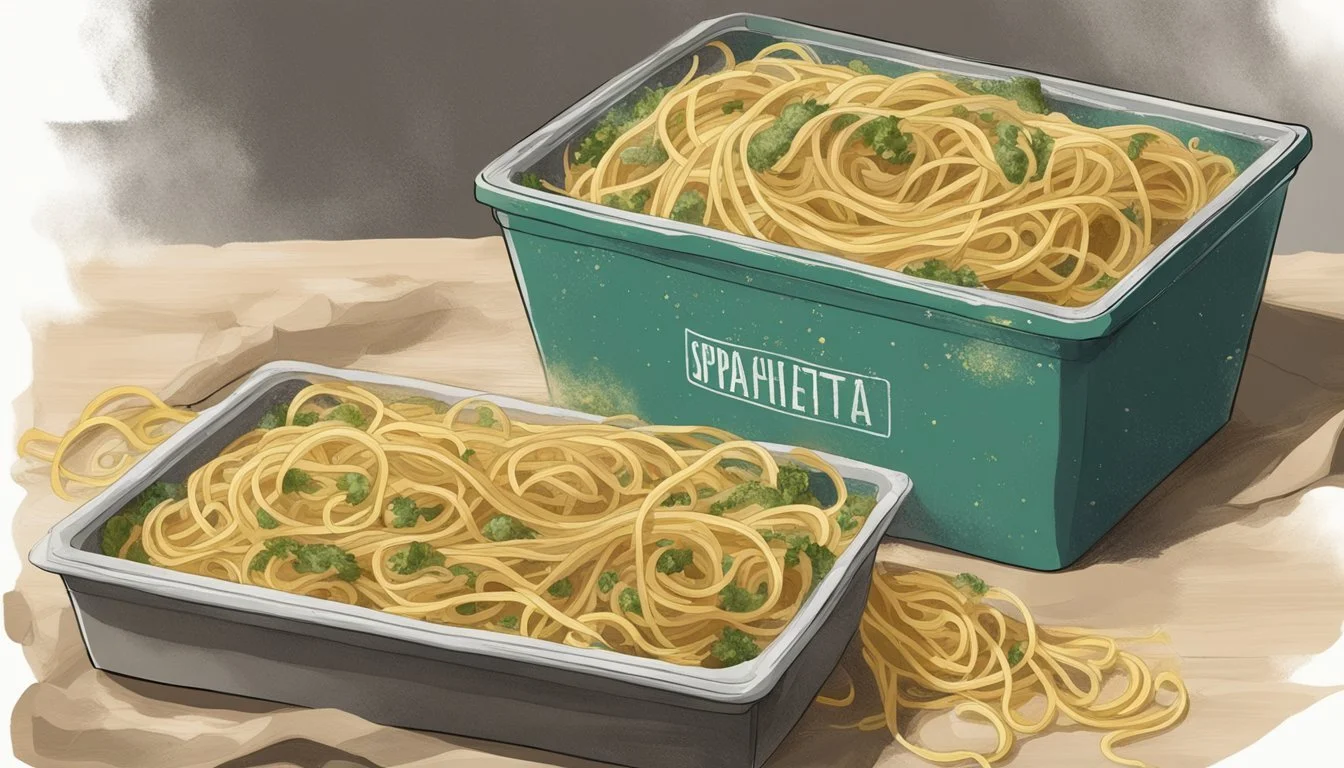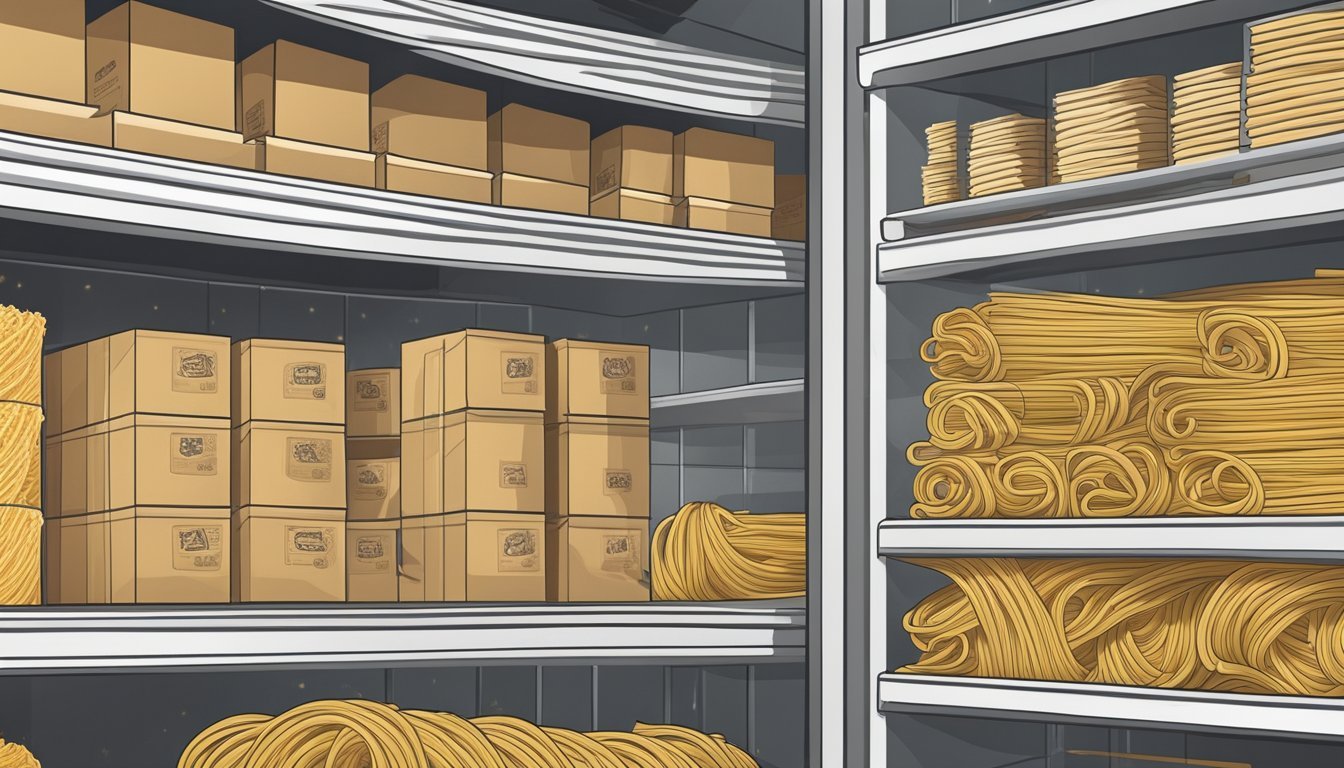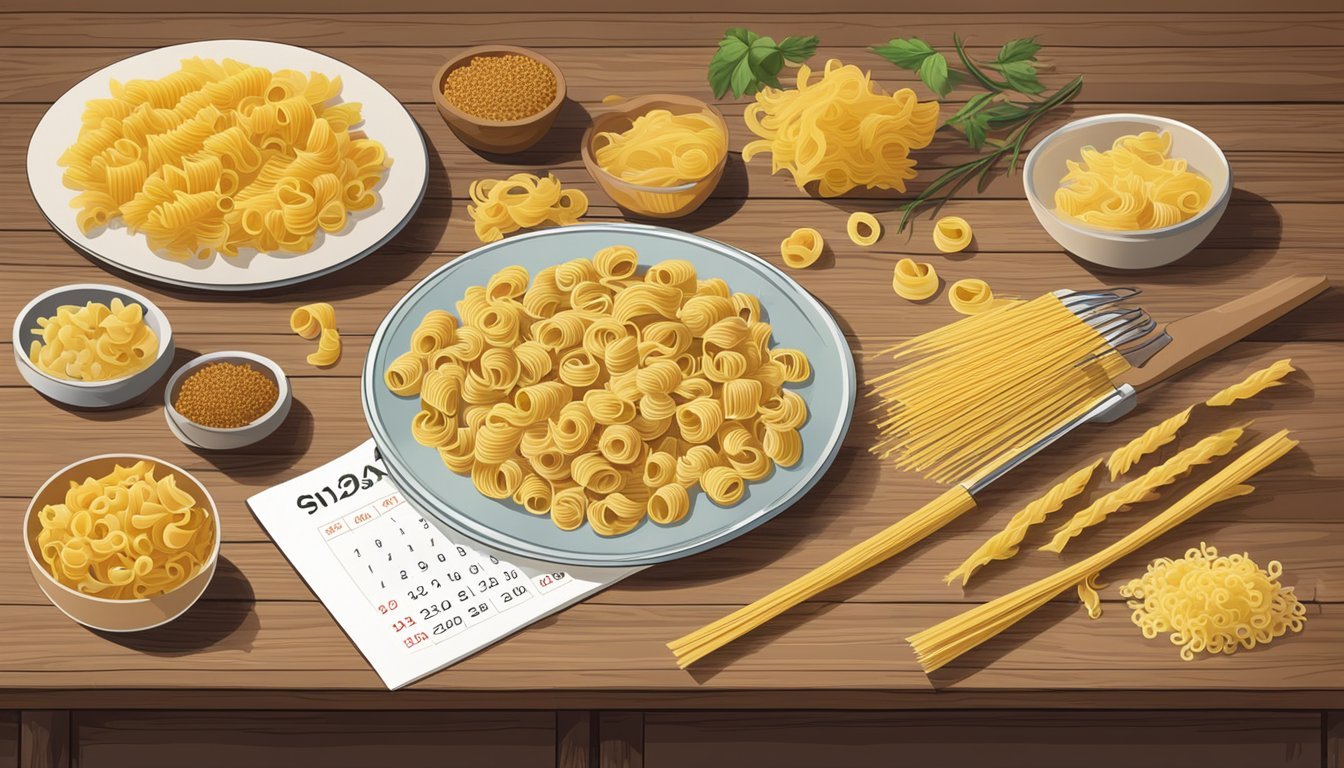How Long Does Spaghetti Pasta Last?
Shelf Life and Storage Tips
The shelf life of spaghetti pasta , a beloved staple in many households, is contingent upon its state—dry, fresh, or cooked. Dry spaghetti, which is uncooked, typically has a long shelf life and can last for 1 to 2 years past the printed "best by" date, as long as it's stored properly in a cool, dry place. This is because dry pasta (What wine goes well with pasta?) is a low-moisture product that hinders bacterial growth, making it less susceptible to spoilage.
Once cooked, however, spaghetti's longevity is significantly reduced due to the increase in moisture, which encourages bacterial growth. Leftover cooked spaghetti should be stored in the refrigerator and is best consumed within 3 to 5 days. To extend its shelf life, cooked spaghetti can also be frozen and is best used within two months for optimal quality. Fresh pasta (how long does fresh pasta last?), on the other hand, contains more moisture and typically has a shorter shelf life, often requiring consumption within a few days if refrigerated or a longer period if properly frozen.
Assessing Pasta Quality
When evaluating the quality of spaghetti pasta, there are several key factors to consider:
Texture: High-quality pasta should have a firm texture. After cooking, it should be al dente, meaning it has a slight resistance when bitten.
Flavor: The pasta should taste of wheat and have a subtle earthiness that complements a variety of sauces.
Appearance: Look for a uniform, golden-yellow color in egg pasta or a rich amber in standard pasta. The surface should be slightly rough to better hold sauces.
Odor: Quality pasta should have a neutral or slightly nutty smell, free from any off or stale odors.
Visual Inspection: Inspect the dry spaghetti for consistency in size and shape, as well as the absence of cracks or discoloration, which can indicate poor manufacturing processes or aged stock.
Cooking Examination: Cook the pasta according to package instructions and then evaluate:
The spaghetti should maintain its form and not become mushy or disintegrate.
It should not release excessive starch, which can result in a gummy texture.
There should be minimal solids lost to cooking water, as more solids lost can signify over-processing or low-quality wheat.
Taste Test: Lastly, a taste test is essential. The spaghetti should not have an overpowering taste on its own but should exhibit a compatible profile that will pair well with sauces and other ingredients in a dish.
Understanding Pasta Shelf Life
The shelf life of pasta varies significantly based on its type—dry, fresh, or cooked—and its storage conditions. Here is a concise guide to pasta shelf life to ensure both safety and quality.
Dry Pasta
Dry pasta is a shelf-stable product that typically has a "best if used by" date rather than a strict expiration date. When stored properly in the pantry, it can last for 1-2 years beyond the date indicated on the package. The longevity of dry pasta is due to its low moisture content, which inhibits the growth of microorganisms that cause food to spoil.
Fresh Pasta
Fresh pasta, containing more moisture and often eggs, is significantly more perishable. In the refrigerator, it has a shelf life of 4-5 days past the "best by" date. It’s important to store it in an airtight container or packaging to maintain its quality. For longer storage, fresh pasta can be frozen, extending its life to about 2 months.
Leftover Cooked Pasta
Leftovers should be approached with care, as cooked pasta is more prone to spoilage due to the moisture introduced during cooking. In an airtight container in the refrigerator, leftover pasta can maintain its quality for up to 5 days. If frozen, cooked pasta can last for 2 months, though quality may vary after thawing and reheating.
Remember to check the pasta for signs of spoilage—such as changes in color, texture, or an off smell—before use, regardless of the type.
Safe Pasta Storage Solutions
Proper storage of pasta is crucial to preserve its quality and extend its shelf life. Whether it is dry or fresh, pasta requires certain conditions to maintain its taste and texture.
Pantry Storage
Dry pasta thrives in a cool, dry, pantry environment away from heat and light. It's a pantry staple that, when stored properly, can last for several years. The best practice for pantry storage includes:
Keeping pasta in airtight containers to protect it from humidity and pantry moths.
Ensuring the storage area is temperature-controlled and not subject to temperature fluctuations.
Refrigerator Storage
Fresh pasta and cooked leftovers have a shorter life span and should be stored in the refrigerator. For optimal freshness, follow these guidelines:
Store fresh pasta in the refrigerator for up to 2-5 days.
Place it in airtight containers or well-sealed plastic bags to prevent it from absorbing fridge odors.
Leftover dishes with pasta that contain meat, sauces, or cheese should be consumed within 3-4 days to avoid spoilage.
Freezer Storage
The freezer offers a long-term solution for both fresh and cooked pasta. To avoid freezer burn and maintain quality, consider these tips:
Freezing fresh pasta can significantly extend its shelf life, up to several months.
Use airtight containers or freezer bags to store fresh or dry pasta in the freezer.
For cooked pasta, such as leftover spaghetti, ensure it cools down before freezing to maintain texture integrity during reheating.
Signs of Spoiled Pasta
When assessing the quality of pasta, it's essential to check for specific signs that indicate spoilage. One can often rely on their senses to detect if the pasta has gone bad, through visual cues, textural changes, an off odor, or a sour taste.
Visual Indicators
One should look for discoloration or moldy spots, which can appear in a variety of colors including white, green, or black. The presence of insects or bugs is another clear sign that the pasta should not be consumed.
Texture Changes
Spoiled pasta may become slimy or gooey, suggesting bacterial growth. If the pasta feels sticky or clumps together abnormally, it may indicate that the pasta has spoiled.
Odor Identification
Pasta that emits an unpleasant or off smell, especially one that is rotten or sour, is indicative of spoilage. A departure from pasta's typical, neutral scent can be a warning sign of bacterial growth and spoilage.
Taste Assessment
The taste of pasta that has gone bad may be starkly different from its original flavor, often becoming sour. However, tasting should be a last resort — if other signs of spoilage are present, it's best not to consume the pasta at all.
Health Considerations
When discussing the longevity of spaghetti pasta, it's imperative to consider the health implications of consuming pasta that has been stored for an extended period. Foodborne illnesses can arise from improperly stored or expired pasta, posing risks to consumer health.
Foodborne Illness Risks
Bacteria Growth: Pasta that is left in the fridge beyond the recommended 3-5 day window can become a breeding ground for bacteria. Common culprits include Bacillus cereus (B. cereus), Salmonella, Campylobacter, and Listeria. These bacteria can multiply rapidly, especially if the pasta is not stored at the proper temperature, typically below 40°F (4°C).
Elderly and Immunocompromised Individuals: These groups are particularly at risk. The elderly, children, pregnant women, and those with weakened immune systems should be extra cautious, as their bodies are less equipped to handle foodborne pathogens.
Symptoms of Food Poisoning: Should harmful bacteria be ingested, individuals may experience a range of symptoms associated with food poisoning. Symptoms can include nausea, vomiting, diarrhea, abdominal cramps, and fever. These effects can vary in severity and duration, but they underscore the importance of consuming pasta within a safe timeframe.
To mitigate health risks, consumers should ensure proper refrigeration of cooked pasta and adhere to recommended storage durations. It's essential to inspect pasta for any signs of spoilage—such as off odors, discoloration, or mold—before consumption. When in doubt, it's safer to discard questionable pasta to avoid the risk of food poisoning.
Maximizing Pasta Longevity
To ensure spaghetti pasta maintains its quality over time, one must focus on proper storage methods, which include adequate sealing to prevent exposure to elements, and an understanding of the environmental factors that can affect its shelf life.
Proper Sealing Techniques
When storing spaghetti pasta, an individual should always strive to create a barrier between the pasta and the external environment. An airtight container or a zip-top bag is ideal for this purpose. To maximize longevity:
Place the dry spaghetti pasta in an airtight container or a zip-top bag, squeezing out as much air as possible before sealing.
For fresh or cooked spaghetti pasta, adding a small amount of olive oil can prevent sticking and may help retain texture. After tossing the pasta with olive oil, store it in an airtight container.
Environmental Factors
Several external conditions can influence the longevity of spaghetti pasta:
Heat: Store pasta in a cool, dry place to prevent deterioration.
Light: Exposure to light can degrade pasta over time, so it should be stored in a dark place or in an opaque container.
Moisture: Any presence of moisture can lead to spoilage, so ensure pasta is kept in a dry environment.
Air: Oxygen can accelerate the degradation process, so limiting air exposure with airtight sealing is crucial.
By mastering these storage techniques, one can maintain the quality of spaghetti pasta for its optimal shelf life.
Reheating and Usage Tips
When it comes to repurposing leftover spaghetti, ensuring delightful taste and safety is paramount. The focus of reheating should be on preserving the pasta's texture and flavor while avoiding the growth of bacteria.
Safe Reheating Practices
Leftover spaghetti when properly stored in the fridge can last for up to 3-5 days. However, safe reheating is essential to prevent foodborne illnesses and maintain quality. Here are the best practices for reheating spaghetti:
Microwave: For small portions, microwaving is efficient. Simply place the spaghetti in a microwave-safe dish, sprinkle a little bit of water to prevent drying out, and cover with a microwave-safe lid or plastic wrap to trap steam that will help reheat the pasta evenly.
Heat on medium power for one to two minutes, stirring once halfway through to ensure even heating.
For spaghetti with sauce, additional sauce can be added before reheating to retain moisture.
Oven: When dealing with larger portions or baked pasta dishes, reheating in an oven is ideal.
Preheat the oven to 350°F (175°C).
Place the spaghetti in an oven-safe dish, cover with aluminum foil to keep the moisture in, and reheat for about 10-15 minutes, depending on the portion size.
Stovetop: This method works well for plain or lightly sauced spaghetti.
Bring a large pot of water to a boil and then turn off the heat.
Place the spaghetti in a colander and dip into the hot water for 30 seconds to one minute.
Drain and toss with a bit of sauce, if available, before serving to freshen the flavors.
For all methods, it's important to ensure the internal temperature of the spaghetti reaches 165°F (74°C) before consumption to destroy any harmful bacteria. Additionally, reheating spaghetti more than once is not advised, as it increases the risk of foodborne illness and can further degrade the quality of the pasta.
Understanding Related Pasta Types
While spaghetti is a well-known pasta type, its shelf life is comparable to a variety of related wheat-based products. This section focuses on alternative wheat pasta types which share similar storage characteristics.
Alternative Wheat Products
Macaroni, another popular wheat pasta, often mirrors spaghetti in terms of shelf life. When refrigerated, cooked macaroni generally remains safe to consume for approximately 3-5 days. For optimal freshness, it should be stored in a tightly sealed container to minimize exposure to bacteria.
Fresh produce like homemade wheat noodles vary slightly, largely dependent on their lack of preservatives. They commonly last 4-5 days in the fridge. In contrast, beans, which are not a pasta but rather a legume, have a different shelf life and should not be confused with grain-based pasta products.
Different pasta types, from angel hair to fusilli, all derive from wheat, the primary grain used in traditional pasta-making. The variations in shape and size do not significantly alter their shelf life. When dry, these pastas can last for an extended period, often up to two years if kept in a cool, dry environment, away from direct sunlight.
Within the gluten-free category, alternative grains such as quinoa, rice, or corn are used to make pasta. These gluten-free options are favorable for those with celiac disease or gluten intolerance and have a similar fridge shelf life to wheat-based noodles when cooked.
Finally, pasta types such as noodles made from fresh wheat may require different storage methods, like freezing, to extend their shelf life beyond the typical 4-5 days in a refrigerator.






